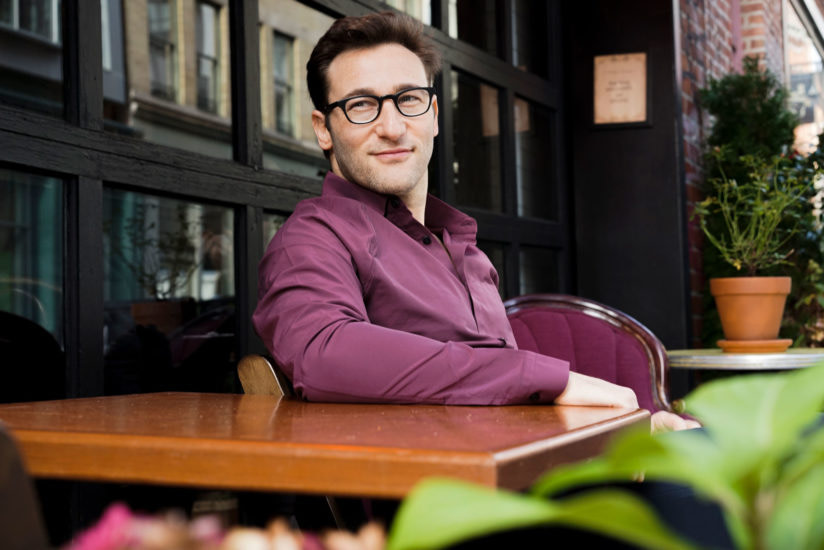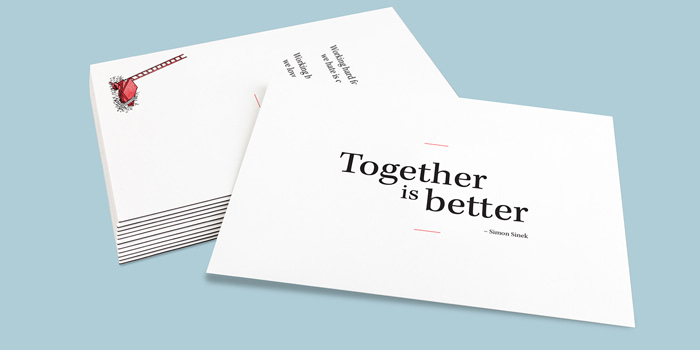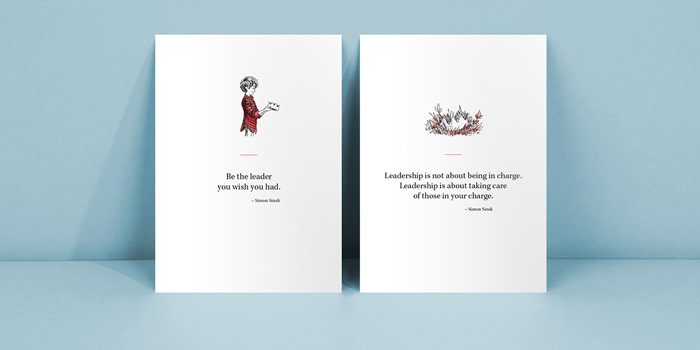MOO + Simon Sinek: working together
Why together is always better

Speaking with Simon Sinek isn’t an experience you forget quickly. His enthusiasm, his belief and his unstoppable optimism shine through every part of our conversation – it’s fast, free-flowing and fun.
We caught up with him to find out more about the ideas that make him tick, his collaboration with MOO and get his latest advice for surviving today’s busy workplace.
Together is better
Simon became widely known following his hugely popular TED talk, How Great Leaders Inspire Action. His distinctive approach – applying behavioural psychology and evolutionary thought to the modern workplace – was captured in his bestselling books Start With Why and Leaders Eat Last. Now, his new book Together is Better, takes a different tack.
Together is Better, challenges its readers to step outside our usual workplace behaviours. It explores cooperation, collaboration and leadership – but here’s the twist – it does so in the style of a fable. An illustrated storybook might not feel the most obvious way to talk about the workplace, but, argues Simon, that’s exactly why it’s a successful format here. “When we teach children,” he explains, “we teach with metaphors and analogies. Stories are more beautiful and the lessons easier to learn. “As adults, it’s really uncomfortable to talk about work and whether or not you’re really happy. To talk about it with a metaphor made it more disarming, and made more of us open to the message. I care more about the message than anything else.”
Safety to take risks
One of the subjects covered in the book is the importance of feeling safe at work. “Safety is a human requirement,” he elaborates. “At work, it’s the comfort to say ‘I don’t know what to do’ without the fear you’re going to get yelled at. That feeling is woefully rare.” This stems, Simon argues, from a lack of a clear purpose, from short-sighted actions for immediate results – from, in short, a lack of good leadership. “Leadership is supposed to provide the vision, long-term,” he says. “A vision is a description of a world that does not yet exist – and if everything we do goes well, we will contribute to building that world. That’s vision.”
So where does safety fit into this? Because when people feel safe, they feel able to take risks. It’s only from a position of safety that we have our chance to learn. And this requires, for a leader, a commitment to both short- and long-term thinking. “It’s the difference between going to the dentist once and brushing your teeth,” Simon elaborates. “If you go to the dentist, your teeth feel fantastic – but if that’s all you do, they’ll fall out. Brushing twice a day, that’s what keeps them clean. “But just brushing your teeth for 2 minutes? It does nothing! It’s not about consistency or intensity – it’s both. That’s why we have so much bad leadership – we favour the short-term. We rely on intensity and forget about consistency.”
Advice for leaders
As leaders, transferring this big-picture advice to day-to-day working life isn’t always easy. Deadlines can mount up, to-do lists can feel a mile long and it can be tough to keep our eyes on the purpose whilst staying motivated. If this happens, Simon’s advice is clear. “Ask for help,” he insists. “You don’t have to know all the answers, or even pretend you do. When you admit you don’t know something, there’s a whole group of people who are so willing to help. The only reason they haven’t already is they didn’t think you needed it – because you were too busy lying, hiding and faking.”
These postcards are little billboards. There to remind you why it’s all worth it.
And at times of stress, reminders that we work better together can be really valuable. With that in mind, we collaborated with Simon on a set of postcards, inspired by Together is Better. “These postcards are little billboards,” Simon explains. “It’s something to sit on your wall, your corkboard or your desk. These cards are there to remind you, when you’re stuck in a lot of short-term goals, of to-do lists and phone calls, why it’s all worth it.”
Always have a vision
Simon writes that we need to plan for the fact that nothing goes to plan. But, he argues, when you know where you’re heading in the end, this needn’t derail your adventure. This difference comes in the vision that your company has. “Here’s the difference in having a plan but no vision,” he explains. “When you ask a company why they’re doing what they’re doing, they say growth. That’s like asking someone where they’re going on holiday, and they say ‘I’m taking the M5.’ “They’ve got all kinds of goals, but no destination. They set out saying they’ll drive 100 miles a day, then get overexcited when they do 130. But what if there are roadworks?”
Whereas, he explains, with a clear destination in mind, like saying you’re on the road to Scotland, it doesn’t matter if you have to take a side road. Even if it looks like you’re going in the wrong direction, you still know where you’re heading. “Plans are important, but they’re very dangerous if you don’t know where you’re going. You can count on there being millions of unforeseen things that will throw you off-plan. You have to be able to adjust – not stop driving to Scotland simply because there are roadworks.”
Losing your passion
Simon’s ideas and approach to leadership come directly from his own experiences. When asked about how he became an author and speaker, he smiles, “I’m an accidental tourist here.” For 4 years, he ran his own consultancy, with the self-propelled passion that most owner/founders will find familiar. But, like many in that position, he found it simply wasn’t a sustainable way to work. “The difference between small organisations and big ones is that small organisations can run on the force of one person,” he explains. “My business ran on personality, but by year 4 we’d grown to such a size where we needed structure and help. I felt I had to have all the answers, and if I didn’t, I pretended that I did.” This, as Simon found, quickly becomes a tough place to be. “I lost my passion,” he admits. “I didn’t want to wake up and do it again, so I invested my energy in pretending I was happier.”
Be open to change
“I ran into a brick wall and realised that direction was no longer open to me,” Simon explained. “But instead of crying that my road was blocked, I was open to taking a different direction.” It was this change in direction that took him to where he is now – and inspired many of the people around him to make radical changes too. “My solution was the discovery of the ‘why’. It gave me a clarity and confidence I’d never had. I shared it with my friends – they started making crazy life changes too.” And before long, this ‘obsession’, as Simon calls it, with purpose, became his new passion. And now, of course, his new job too. “Anyone can achieve something if they’re open to it,” he insists. “Those choices are available to all of us – if you remember that you can’t do it alone.” And that, we think, is something worth remembering every day.
Need another Simon Sinek fix? Check out our summary of his seminal TED Talk.
Keep in touch
Get design inspiration, business tips and special offers straight to your inbox with our MOOsletter, out every two weeks.







